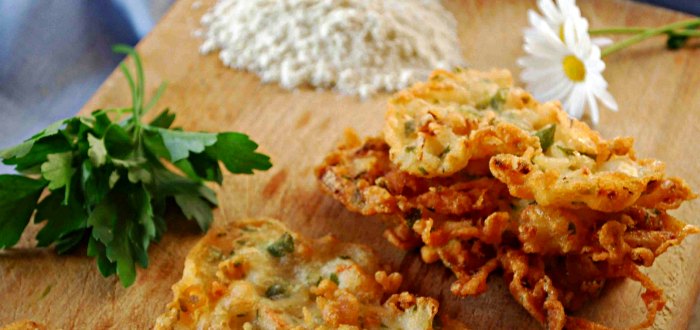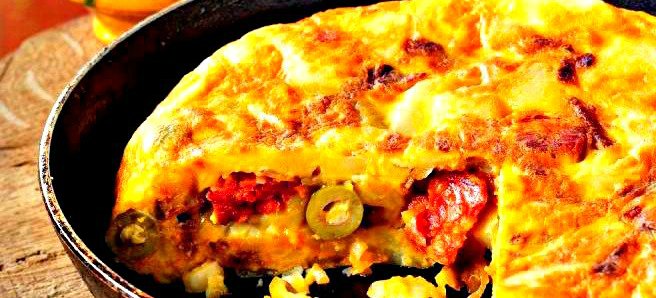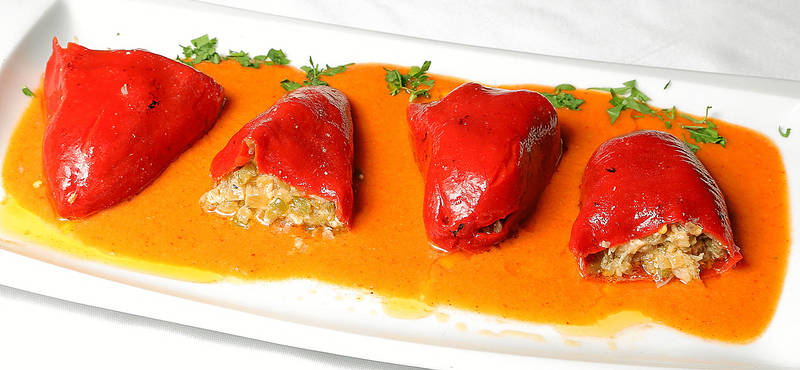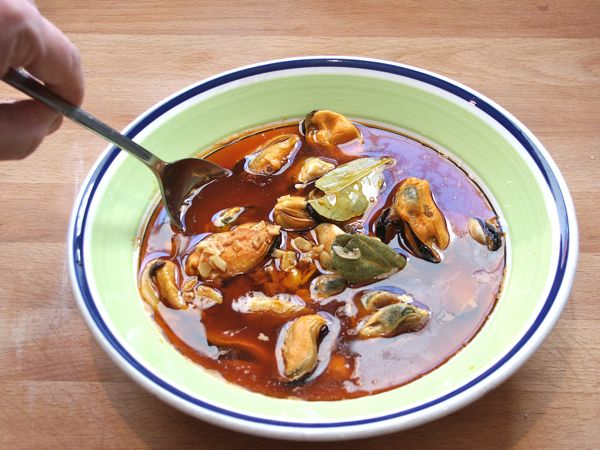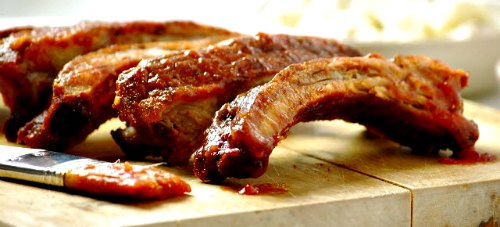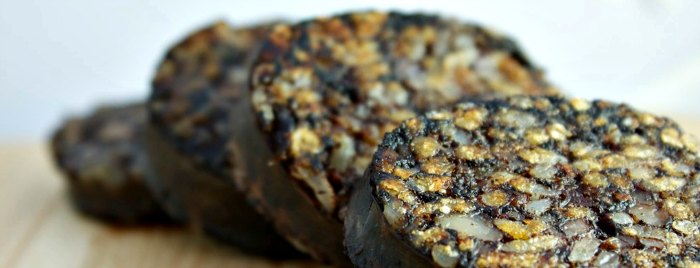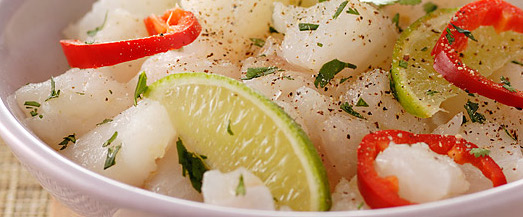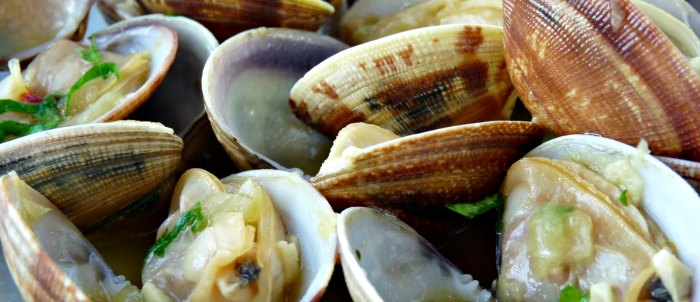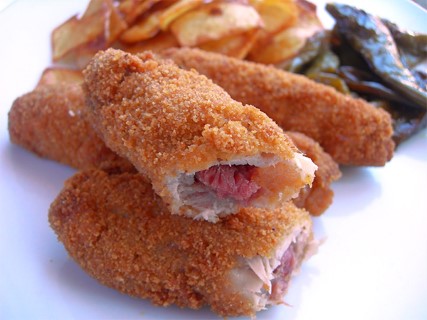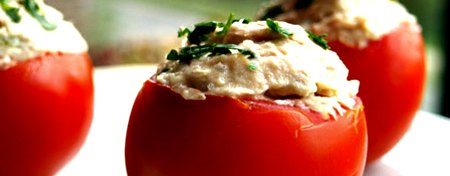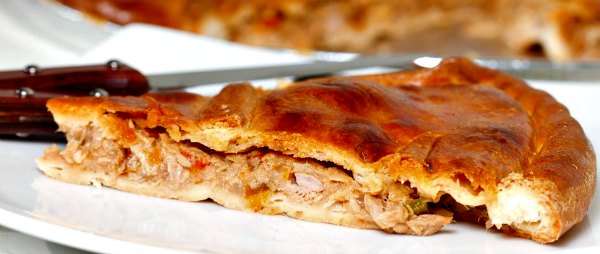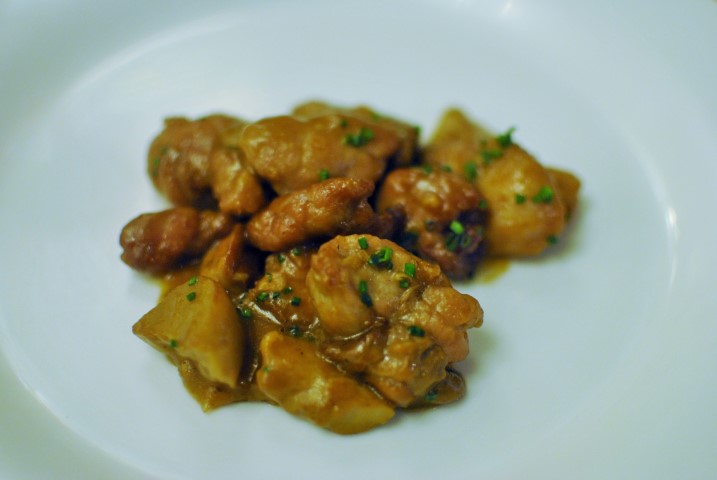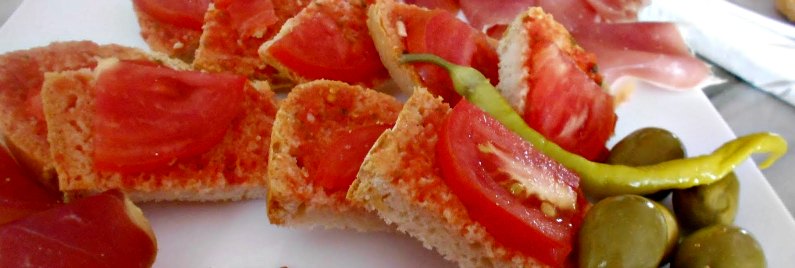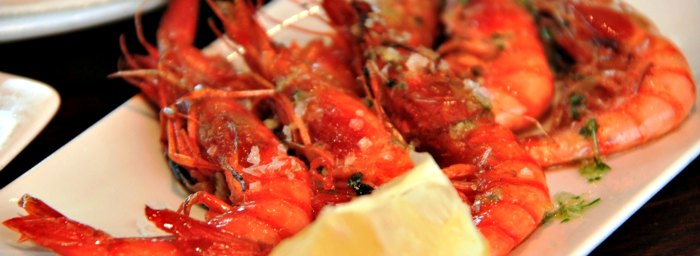Spanish Tapas Recipes
In the Mediterranean diet it is typical to begin the food with succulent starters to open up the appetite. Either in complete portions or in half rations - the famous ‘tapas’ – appetizers are usually served before the food.
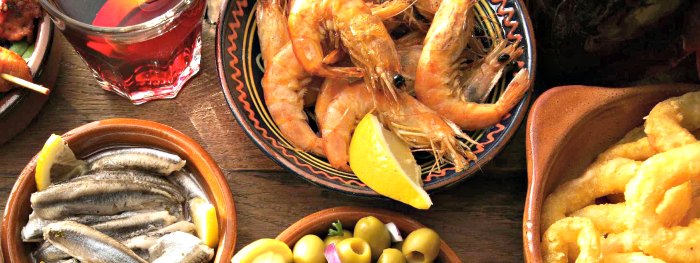
Of the endless variety of starters that is possible to find - there is not town that doesn't have his own - we introduce a selection that we believe you will really enjoy.
Our tapas selection
|
Foie Toast with Jamon Ibérico: This extraordinary and Special Ham deserves its own space. The Iberian Acorn Ham it's exclusive from Spain. Iberian hogs are born, fed and raised in the south and northwest of Spain |
|
Shrimp Fritters - Tortillitas de Camarones: I have eaten these crisp, delicious shrimp fritters only in Andalusia, where deep-frying reigns supreme. They are at their best when made with chickpea flour, but regular flour is just OK. |
|
Spicy Sausage and Cheese Tortilla: This substantial tortilla is delicious hot or cold. Cut it into chunky wedges and serve for supper or a light lunch with a fresh tomato and basil salad. The addition of spicy chorizo and tangy cheese gives it a wonderful, rich flavor. |
Pimientos del piquillo rellenos (Stuffed piquillo peppers): Vegetables don't care about borders, and even if piquillo peppers are considered a Navarran specialty, neighbors next door in La Rioja claim some rights over the celebrated peppers. Here, they are stuffed in the manner of Logroño, the capital of the region and a good starting point for visiting a number of excellent nearby wine cellars.
Mejillones en escabeche: En escabeche is a traditional method of preserving foods that was frequently used before refrigeration. Castilla– La Mancha is known for its superb escabeches, of which this is just one good example. The mussels will keep in the refrigerator for up to a week.
|
Barbecued Mini Ribs: These tasty ribs are known as Costillas in Spain. They are delicious cooked on a barbecue and almost as good when cooked under a hot grill. If you prefer a sweeter flavor, use freshly squeezed orange juice instead of the sweet sherry. |
|
Fried Black Pudding (Morcilla Frita): Spanish morcilla - black pudding - is the first sausage to be made from the freshly killed pig and is very popular throughout Spain. It is flavored with spices and herbs, usually including garlic and oregano, and has a wonderfully rich, spicy taste. |
|
Ceviche: You can use almost any firm-fleshed fish for this Spanish influenced dish, provided that it is perfectly fresh. The fish is 'cooked' by the action of the acidic lime juice. Adjust the amount of chilli according to your taste. |
|
Spiced Clams: Spanish clams, specially in the North, are much larger than clams found elsewhere, and have more succulent bodies. This modern recipe uses Arab spicing to make a hot dip or sauce. Serve with plenty of fresh bread to mop up the delicious juices! |
Flamenquines are typically served as a tapa, but I most often eat them as a light dinner main course at the home of friends in the Andalusian town of Andujar, which is surrounded by beautiful sunflower fields in full bloom in September. You can also make these rolls with beef instead of pork, and some people like to add slices of cheese. Whichever ingredients you choose, these rolls are unforgettable.
|
Stuffed Tomatoes tapas: This one is a simple recipe, very handy when preparing a barbeque or a picnic party. Tomatoes here are used as a container for a delicious Spanish stuffing. |
Salt Cod Fritters with Allioli: Bacalao - salt cod - is one of the great Spanish delights, adding flavor to bland ingredients such as potatoes. If you are unfamiliar with it, then this is a delightful way to try it out. Bitesize fish cakes, dipped into rich, creamy, garlicky allioli, are irresistible as a tapas dish or appetizer.
Artichoke rice cakes with manchego: These unusual little croquetas contain artichoke in the rice mixture, and they break open to reveal a melting cheese centre. Manchego is made from sheep's milk and has a tart flavor that goes wonderfully with the delicate taste of the rice cakes.
Prawn croquettes: Croquetas are ubiquitous in Spain, although they most likely originate from the French 'croquettes'. Their beauty lies in the bechamel base which is then mixed with your particular ingredient of choice to give it a characteristic flavor. The possibilities are almost endless - here we have used prawns.
Prawn and Bacon Brochettes: The Spanish love bacon, which we cure and air-dry in the same way as our famous jamon. This combination of prawns and bacon is inspired and very popular, and can be found at most Tapas bar, as well as in many banquets and receptions. It is an ideal treat for your guests when having a party at home!
Gildas: Gilda means lollipop, and the classic Gilda is a simple assembly of a guindilla (Spanish chile pepper), an anchovy and an olive. The combination of good-quality pinkish anchovies, smallish, crisp, unwrinkled chillies and a freshly pitted olive produce a sophisticated mélange.
Smoked Fish and Fruit Pintxos: Smoked fish and fresh fruit make a perfect match when combined in this recipe and served as an appetizer. Smoked salmon is now ubiquitous in Spain, particularly in the cities. Less evidence is traditional bacalao (salt cod), for which smoked mackerel is a substitute here.
Artichokes with clams: Artichokes are a popular vegetable in Spain, especially fresh from the market. They are often served sautéed with ham or stuffed with white sauce and ham or meat, etc. Sometimes served cold, they combine well with anchovies and piquillo peppers, or with salmon and capers, or tuna fish with a good olive oil.
Patatas bravas: A classic! Spicy and hot fried potatoes, with a Brava sauce to match!
Stuffed Mussels (Tigres): In Bilbao, these stuffed mussels are called Tigres because of their fieriness. I fondly remember the crowded little bars in the old part of Bilbao, where orders of tigres would emerge by the dozens from the tiny kitchens.
Empanadas: bread pies stuffed with shellfish, fish or meats, are iconic of Galician cuisine. The crusts and fillings vary from place to place, and nearly every Galician family, restaurant, and tavern claims to have the secret formula for making the best version. Of the many empanadas I have tasted in this beautiful northwestern region, these ones are my favorites - their crust is consistently delicate and delicious.
Mollejas salteadas: Many people think of sweetbreads (mollejas) as an exotic ingredient served only at upscale restaurants, but they are actually simple to prepare at home... A classical Madrid tapa, by the way!
Bread with Mushrooms and Alioli: This tapa recipe comes from a bar in Madrid. I used to jog around the Retiro and then eat these tostadas washed down with a nice cold caña! When I serve this recipe at a party, it is always the first to go!
Mussels Vinaigrette: Steamed mussels are dressed with a flavorful vinaigrette in this colorful tapa. It is an ideal treat for a party or any event with lots of people attending.
|
Pa amb oli. Pa amb oli means "bread with olive oil" in Majorcan, and it is as commonly eaten in the Balearic Islands as pa amb tomàquet is in Catalonia. As with pa amb tomàquet, this recipe can be embellished with a topping of jamón serrano, anchovies, or cheese. |
|
Pulpo a Feira: Though it originated in Galicia or the neighboring region of Leon, pulpo a feira, as it is known in Galician, or pulpo a la gallega, as it is called in Spanish, is now popular throughout Spain. It is usually served on wooden plates with cachelos, potatoes that have been boiled or roasted in embers with their skins on. |
Pimientos rellenos (Rice-stuffed peppers): The rice to fill these stuffed peppers, which are typical of the mountain towns of Alcoy and Bocairent, cooks in the sweet juices from the tomato and pepper.
|
Gambas a la plancha (Pan-grilled shrimp): Spaniards love to eat grilled shrimp at the counter of a good tapas bar while sipping a glass of chilled fino sherry or cold beer. The bars are often crowded, leaving little or no space for proper eating, and I find it fascinating to watch the locals skillfully manage to eat shrimp with one hand while holding a drink in the other. |
Ensaladilla Rusa (Spanish Potato Salad): This is a popular tapa recipe, made of vegetables and mayonnaise... It is served free in most bars in Spain, along with a beer or a glass of wine.
Spanish Ham Croquettes: Croquetas are a common sight on bar counters and in homes across Spain, served as a tapa, light lunch, or a dinner along with a salad. The jamon serrano in this recipe could be replaced with chopped hard-boiled eggs, shredded salt cod, minced shrimp, chopped chorizo, cheese, or just about any vegetable.
Spanish omelette: This is THE tapa! There is nothing more typical than a Spanish omelette! Learn how to prepare the real one!
Piperada is a filling egg dish, which makes a delicious brunch, and it can also be served as a tapa. A popular variation of this recipe serves the piperada on toasted bread rounds dripping with butter. Either way, this simple egg dish is sure to become a part of your culinary repertoire.
Green Aparaguses with Salmon: This innovative tapa recipe puts together traditional Spanish ingredients with northern salmon... Try this new classic tapa!
Catalan Style Beans: Habas are a traditional type of Spanish bean, that Catalan chefs (after their grandmother's cookbook!) have turn into one of the greatest tapas nowadays!
Meatballs in tomato sauce: found in most tapas bars, this traditional dish tastes best when served piping hot straight from the pan. Provide plenty of fresh bread to mop up the juicy tomato sauce.
Tuna and goat cheese empanadillas: Empanadillas, the smaller, pocket-size versions of empanadas, are generally served as tapas, and, because no silverware is required to eat them, make perfect party food.
Garlic-marinated Black Olives: Attesting to the simplicity of tapas, a handful of marinated olives is often ample accompaniment to a glass of chilled sherry in most Spanish tapas bars. Marinated to piquant perfection, these olives are far from ordinary.
Apple and Walnut Salad: This refreshing, crisp summer salad provides the perfect accompaniment to a glass (or two) of chilled Spanish sherry. For a tangier version, add a dash of lemon juice to the mayonnaise before mixing it into the salad.
Champiñones al ajillo: Few tapas taste more Spanish than champiñones al ajillo (ajillo mushrooms), dripping with olive oil, garlic and dry Spanish Sherry.
Red Onion and Orange Salad: This popular and colorful salad lends a festive note to any tapas table, and is featured in many tapas bar throughout Spain.
Riñones al Jerez - Sherry Kidneys: Most tapas bars in Spain serve Riñones al Jerez, though at home it can be served with rice or pasta as a main meal. You can add sliced mushrooms to increase the number of portions.
Boquerones en Escabeche: Moorish Pickled Anchovies This is an old, old way of preserving small fish which has survived into modern times because it is so delicious. The coast round Nerja is known for its shoals of fresh anchovies. In Malaga the fish are pressed together into a little fan, four tails together, for frying, but this is not essential to the recipe.
Pinchitos Morunos: Small Spicy Moorish Kebabs Europe's first kebabs were brought by the Arabs from Africa. Pinchitos morunos are eaten everywhere in Spain as a tapa, though nowadays they are made of pork, rather than lamb. Spices for them are sold ready-mixed in the south. I have used curry powder as part of my mixture as it contains cumin and very similar herbs.
Asparagus Omelette: Although this unique omelette is usually served from the skillet, it is also delicious served cold or at room temperature. Indeed, cooled leftovers of this delectable dish with a glass of amontillado sherry make for a perfect picnic lunch.

